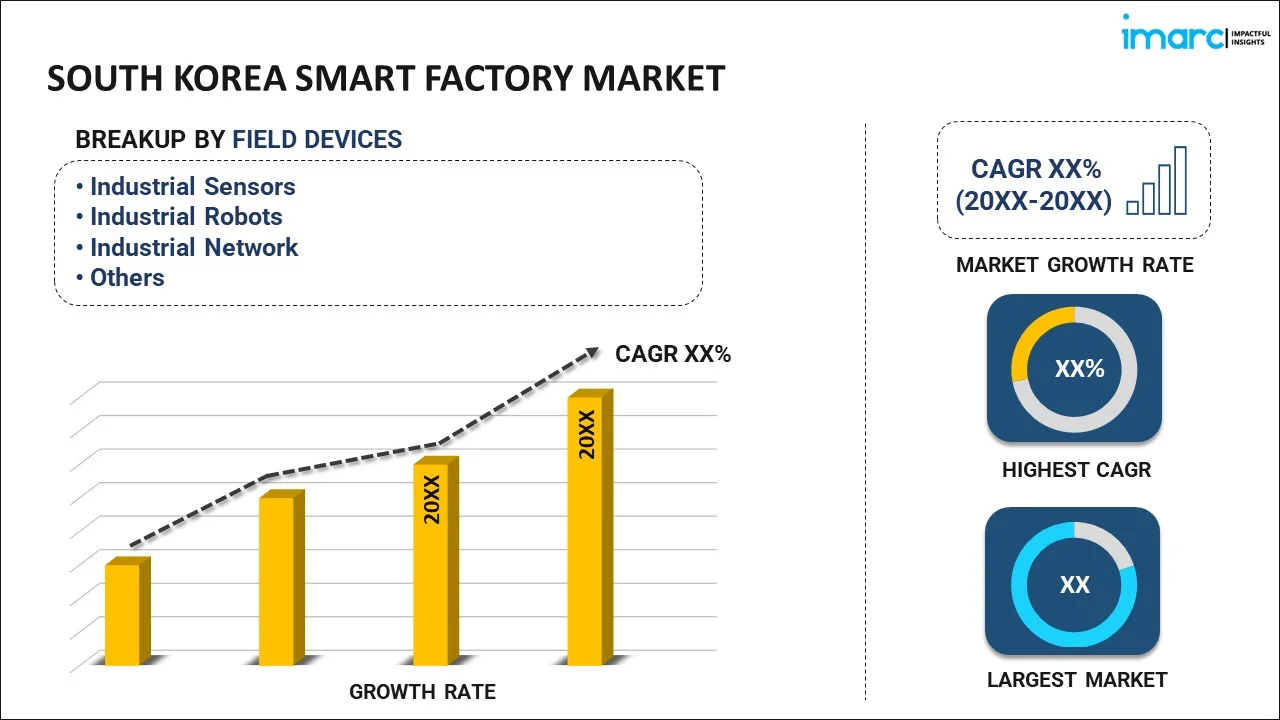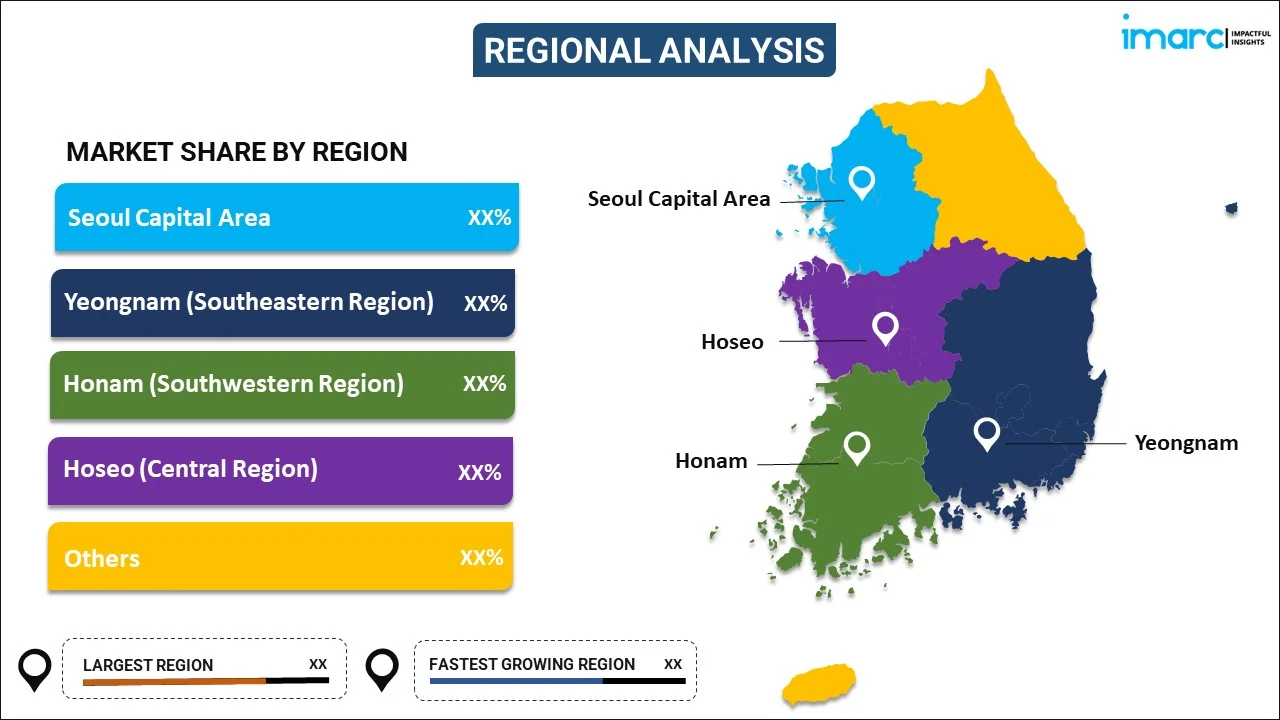
South Korea Smart Factory Market Report by Field Devices (Industrial Sensors, Industrial Robots, Industrial Network, Industrial 3D Printers, Machine Vision Systems), Technology (Product Lifecycle Management (PLM), Human Machine Interface (HMI), Enterprise Resource Planning (ERP), Manufacturing Execution Systems (MES), Distributed Control Systems (DCS), Industrial Control System, and Others), End Use Industry (Pharmaceuticals, Food and Beverages, Chemical, Oil and Gas, Automotive and Transportation, Semiconductor and Electronics, Aerospace and Defense, and Others), and Region 2025-2033
Market Overview:
South Korea smart factory market size is projected to exhibit a growth rate (CAGR) of 9.79% during 2025-2033. The increasing preferences of individuals for customized and personalized products, the development of a robust digital ecosystem, and rising collaborations between industries and academic institutions represent some of the key factors driving the market.
|
Report Attribute
|
Key Statistics
|
|---|---|
|
Base Year
|
2024 |
|
Forecast Years
|
2025-2033
|
|
Historical Years
|
2019-2024
|
| Market Growth Rate (2025-2033) | 9.79% |
A smart factory, also known as Industry 4.0 or the Industrial Internet of Things (IIoT), refers to a highly automated and connected manufacturing facility that leverages advanced technologies, such as sensors, artificial intelligence (AI), machine learning (ML), and data analytics to optimize and streamline production processes. It facilitates data sharing and analysis for informed decision-making. It employs interconnected devices and systems to facilitate seamless communication between various components. It is integrated with robotics and automated machinery that helps enhance efficiency and reduce manual labor. It supports the transformation of physical processes into digital representations, allowing better monitoring and control. It offers improved visibility and coordination in the supply chain. It is widely used in the production of goods across various industries.
South Korea Smart Factory Market Trends:
The rising preferences of individuals in South Korea for customized and personalized products represent one of the primary factors propelling the market growth. Smart manufacturing allows for greater flexibility and adaptability in production processes, making it easier for companies in the country to meet these evolving consumer demands. Along with this, the development of a robust digital ecosystem, including advanced telecommunications infrastructure and a high level of internet penetration, is facilitating the market growth. This digitalization is allowing companies to connect their manufacturing processes seamlessly, share real-time data, make data-driven decisions, and enhance smart manufacturing capabilities. Apart from this, continuous technological advancements are supporting the growth of the market. The integration of cutting-edge technologies, such as the Industrial Internet of Things (IIoT), artificial intelligence (AI), robotics, and advanced analytics, is also driving the transformation of traditional manufacturing processes. These technological advancements enhance efficiency, reduce production costs, and improve product quality. Furthermore, governing authorities of South Korea are undertaking several initiatives to foster a conducive environment for the adoption of smart factory technologies. They are also offering incentives, research and development (R&D) grants, and policy frameworks for encouraging businesses to invest in smart manufacturing. Moreover, the implementation of stringent data security measures and regulations to introduce a safe and secure environment for smart factory solutions is favoring the market growth. In line with this, the integration of fifth-generation (5G) technology is improving the operational efficiency of smart factories. 5G enables faster and more reliable communication within smart factory ecosystems. This enhanced connectivity facilitates real-time data exchange, remote monitoring, and control of manufacturing processes. Besides this, rising collaborations between industries and academic institutions are creating a positive outlook for the market. Joint research projects, knowledge exchange, and talent development programs are fostering innovation and facilitating the development of advanced smart factory solutions.
South Korea Smart Factory Market Segmentation:
IMARC Group provides an analysis of the key trends in each segment of the market, along with forecasts at the country level for 2025-2033. Our report has categorized the market based on field devices, technology, and end use industry.
Field Devices Insights:

- Industrial Sensors
- Industrial Robots
- Industrial Network
- Industrial 3D Printers
- Machine Vision Systems
The report has provided a detailed breakup and analysis of the market based on the field devices. This includes industrial sensors, industrial robots, industrial network, industrial 3D printers, and machine vision systems.
Technology Insights:
- Product Lifecycle Management (PLM)
- Human Machine Interface (HMI)
- Enterprise Resource Planning (ERP)
- Manufacturing Execution Systems (MES)
- Distributed Control Systems (DCS)
- Industrial Control System
- Others
A detailed breakup and analysis of the market based on the technology have also been provided in the report. This includes product lifecycle management (PLM), human machine interface (HMI), enterprise resource planning (ERP), manufacturing execution systems (MES), distributed control systems (DCS), industrial control system, and others.
End Use Industry Insights:
- Pharmaceuticals
- Food and Beverages
- Chemical
- Oil and Gas
- Automotive and Transportation
- Semiconductor and Electronics
- Aerospace and Defense
- Others
The report has provided a detailed breakup and analysis of the market based on the end use industry. This includes pharmaceuticals, food and beverages, chemical, oil and gas, automotive and transportation, semiconductor and electronics, aerospace and defense, and others.
Regional Insights:

- Seoul Capital Area
- Yeongnam (Southeastern Region)
- Honam (Southwestern Region)
- Hoseo (Central Region)
- Others
The report has also provided a comprehensive analysis of all the major regional markets, which include Seoul Capital Area, Yeongnam (Southeastern Region), Honam (Southwestern Region), Hoseo (Central Region), and Others.
Competitive Landscape:
The market research report has also provided a comprehensive analysis of the competitive landscape. Competitive analysis such as market structure, key player positioning, top winning strategies, competitive dashboard, and company evaluation quadrant has been covered in the report. Also, detailed profiles of all major companies have been provided.
South Korea Smart Factory Market Report Coverage:
| Report Features | Details |
|---|---|
| Base Year of the Analysis | 2024 |
| Historical Period | 2019-2024 |
| Forecast Period | 2025-2033 |
| Units | Million USD |
| Scope of the Report | Exploration of Historical and Forecast Trends, Industry Catalysts and Challenges, Segment-Wise Historical and Predictive Market Assessment:
|
| Field Devices Covered | Industrial Sensors, Industrial Robots, Industrial Network, Industrial 3D Printers, Machine Vision Systems |
| Technologies Covered | Product Lifecycle Management (PLM), Human Machine Interface (HMI), Enterprise Resource Planning (ERP), Manufacturing Execution Systems (MES), Distributed Control Systems (DCS), Industrial Control System, Others |
| End Use Industries Covered | Pharmaceuticals, Food and Beverages, Chemical, Oil and Gas, Automotive and Transportation, Semiconductor and Electronics, Aerospace and Defense, Others |
| Regions Covered | Seoul Capital Area, Yeongnam (Southeastern Region), Honam (Southwestern Region), Hoseo (Central Region), Others |
| Customization Scope | 10% Free Customization |
| Post-Sale Analyst Support | 10-12 Weeks |
| Delivery Format | PDF and Excel through Email (We can also provide the editable version of the report in PPT/Word format on special request) |
Key Questions Answered in This Report:
- How has the South Korea smart factory market performed so far and how will it perform in the coming years?
- What has been the impact of COVID-19 on the South Korea smart factory market?
- What is the breakup of the South Korea smart factory market on the basis of field devices?
- What is the breakup of the South Korea smart factory market on the basis of technology?
- What is the breakup of the South Korea smart factory market on the basis of end use industry?
- What are the various stages in the value chain of the South Korea smart factory market?
- What are the key driving factors and challenges in the South Korea smart factory?
- What is the structure of the South Korea smart factory market and who are the key players?
- What is the degree of competition in the South Korea smart factory market?
Key Benefits for Stakeholders:
- IMARC’s industry report offers a comprehensive quantitative analysis of various market segments, historical and current market trends, market forecasts, and dynamics of the South Korea smart factory market from 2019-2033.
- The research report provides the latest information on the market drivers, challenges, and opportunities in the South Korea smart factory market.
- Porter's five forces analysis assist stakeholders in assessing the impact of new entrants, competitive rivalry, supplier power, buyer power, and the threat of substitution. It helps stakeholders to analyze the level of competition within the South Korea smart factory industry and its attractiveness.
- Competitive landscape allows stakeholders to understand their competitive environment and provides an insight into the current positions of key players in the market.
Need more help?
- Speak to our experienced analysts for insights on the current market scenarios.
- Include additional segments and countries to customize the report as per your requirement.
- Gain an unparalleled competitive advantage in your domain by understanding how to utilize the report and positively impacting your operations and revenue.
- For further assistance, please connect with our analysts.
 Request Customization
Request Customization
 Speak to an Analyst
Speak to an Analyst
 Request Brochure
Request Brochure
 Inquire Before Buying
Inquire Before Buying




.webp)




.webp)












